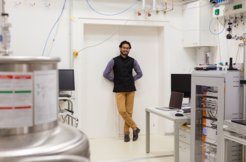Successful PhD defense of Ankit Kumar Sharma
Congratulations to Ankit Kumar Sharma!
Title: "Probing Non-collinear Spin Textures using Variable Temperature Magnetic Force Microscopy" |
Abstract
The emergence of magnetic skyrmions, which are topological spin textures, has aroused tremendous research interest from both a fundamental physics perspective as well as from their potential application in next-generation energy-efficient and high-density spintronic devices. In this thesis, various kinds of non-collinear spin textures are investigated in bulk crystals and thin films of three non-centrosymmetric compounds. Variable temperature magnetic force microscopy is the main research tool that was used to probe these novel spin textures.
First, the properties of antiskyrmions are studied in single-crystalline lamellae of the inverse tetragonal Heusler compound Mn1.4PtSn that has a crystal structure with D2d crystalline symmetry. A major discovery of this work was the extreme tunability of the size of the antiskyrmion and the period of the helical state as the thickness of the lamella in which the spin textures are observed is increased. This thickness dependence tunability is attributed to the significant influence of magnetic dipolar interactions as compared to the thickness-independent Dzyaloshinskii-Moriya interaction.
Secondly, spin textures are explored in epitaxially grown thin films of another Heusler compound, Mn2RhSn, that also has D2d symmetry. These nano-objects exhibit a wide range of stability with respect to magnetic field and temperature that is similar to single-crystalline lamellae. Elliptically distorted nano-objects along perpendicular crystallographic directions within the epitaxial films are found that is consistent with elliptical Bloch skyrmions observed in single-crystalline lamellae of Mn2RhSn. A small increase in the size of nano-objects is observed with increasing film thickness, which is a much smaller variation than the D2d bulk Mn1.4PtSn crystal due to the comparatively lower magnetization of Mn2RhSn. The creation and annihilation of nano-objects using a local magnetic field from a magnetic tip are shown in these thin films.
Thirdly, Néel skyrmions were discovered in the single crystalline lamella of the compound PtMnGa which we showed has a non-centrosymmetric crystal structure: prior to this work, this compound was believed to have a centrosymmetric structure for more than 30 years. The thickness dependence of the size of the Neel skyrmion size is studied. A significant dependence of size on thickness is found: this is only the second materials system in which such a phenomenon has been found. Moreover, this compound is the first metallic system in which Néel skyrmions have ever been observed. Prior work showed the existence of Néel skyrmions in two insulating compounds but only at very low temperatures: here we observe Néel skyrmions at temperatures as high as 220 K.













